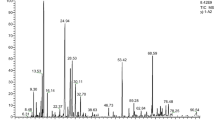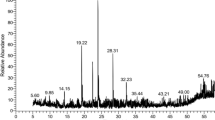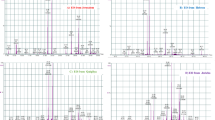Abstract
Tea tree oil (TTO) is a yellow liquid extracted from Melaleuca alternifolia. Although the antimicrobial activity of TTO has been known for a long time, its specific antimicrobial effects and mechanism underlying these remain poorly characterized. The present study investigated the chemical composition of TTO and the dynamics and mechanism of its antimicrobial activities in two bacterial and two fungal strains. Gas chromatography–mass spectrometry analysis identified alkenes and alcohols as the main constituents of TTO. Terpinen-4-ol was the most abundant individual component, accounting for approximately 23 % of the TTO. Poisoned food technique assessment showed that the minimum inhibitory concentrations of TTO for bacterial strains (Escherichia coli and Staphylococcus aureus) and fungal strains (Candida albicans and Aspergillus niger) were 1.08 and 2.17 mg/mL, respectively. Antimicrobial dynamic curves showed that with increasing concentrations of TTO, the rate of cell killing and the duration of growth lag phase increased correspondingly. These data indicated that TTO produced concentration and time-dependent antimicrobial effects. The minimum bactericidal and fungicidal concentrations of TTO were 2.17, 4.34, and 4.34 against E. coli, S. aureus, and C. albicans, respectively. However, A. niger conidia were not completely eradicated, even after 3 days in the presence of 17.34 mg/mL TTO. Transmission electron microscopy images indicated that TTO penetrated the cell wall and cytoplasmic membrane of all the tested bacterial and fungal strains. TTO may also penetrate fungal organelle membrane. These findings indicated that TTO maybe exerts its antimicrobial effects by compromising the cell membrane, resulting in loss of the cytoplasm and organelle damage, which ultimate leads to cell death.





Similar content being viewed by others
References
Arweiler NB, Donos N, Netuschil L, Reich E, Sculean A (2000) Clinical and antibacterial effect of tea tree oil—a pilot study. Clin Oral Investig 4:70–73
Avato P, Tursi F, Vitali C, Miccolis V, Candido V (2000) Allylsulfide constituents of garlic volatile oil as antimicrobial agents. Phytomedicine 7(3):239–223
Bishop CD (1995) Antiviral activity of the essential oil of Melaleuca alternifolia (maiden and Betche) Cheel (tea tree) against tobacco mosaic virus. J Essent Oil Res 7:641–644
Brophy JJ, Davies NW, Southwell IA, Stiff IA, Williams LR (1989) Gas chromatographic quality control for oil of Melaleuca terpinen-4-ol type (Australian tea tree). J Agric Food Chem 37:1330–1335
Campli ED, Bartolomeo SD, Pizzi PD, Giulio MD, Grande R, Nostro A, Cellini L (2012) Activity of tea tree oil and nerolidol alone or in combination against Pediculus capitis (head lice) and its eggs. Parasitol Res 111(5):1985–1992
Carson CF, Cookson BD, Farrelly HD, Riley TV (1995) Susceptibility of methicillin-resistant Staphylococcus aureus to the essential oil of Melaleuca alternifolia. J Antimicrob Chemother 35:421–424
Carson CF, Mee BJ, Riley TV (2002) Mechanism of action of Melaleuca alternifolia (tea tree) oil on Staphylococcus aureus determined by time-kill, lysis, leakage, and salt tolerance assays and electron microscopy. Antimicrob Agents Chemother 46(6):1914–1920
Carson CF, Riley TV (1993) Antimicrobial activity of the essential oil of Melaleuca alternifolia. Lett Appl Microbiol 16:49–55
Delespaul Q, Billerbeck VG, Roques CG, Michel G (2000) The antifungal activity of essential oils as determined by different screening methods. J Essent Oil Res 12:256–266
European Directorate for the Quality of Medicines (2006): the 5th Edition of European Pharmacopoeia and its subsequent supplements. 5.5 CD-Rom.
Evgeny VU, Oleg VP, Olga VU (2013) Antiviral activity of tea tree and eucalyptus oil aerosol and vapour. J Aerosol Sci 59:22–30
Garozzo A, Timpanoro R, Stivala A, Bisignano G, Castro A (2011) Activity of Melaleuca alternifolia (tea tree) oil on influenza virus a/PR/8: study on the mechanism of action. Antivir Res 89:83–88
Hammer KA, Carson CF, Riley TV (1996) Susceptibility of transient and commensal skin flora to the essential oil of Melaleuca alternifolia (tea tree oil). Am J Infect Control 24:186–189
Hammer KA, Carson CF, Riley TV (1997) In vitro susceptibility of Malassezia furfur to the essential oil of Melaleuca alternifolia. J Med Vet Mycol 35:375–377
Hammer KA, Carson CF, Riley TV (1998) In vitro activity of essential oils, in particular Melaleuca alternifolia (tea tree) oil and tea tree oil products, against Candida spp. J Antimicrob Chemother 42:591–595
Hammer KA, Carson CF, Riley TV (1999) In vitro susceptibilities of Lactobacilli and organisms associated with bacterial vaginosis to Melaleuca alternifolia (tea tree) oil. Antimicrob Agents Chemother 43(1):196–196
Hammer KA, Carson CF, Riley TV (2000) In vitro activities of ketoconazole, econazole, miconazole, and Melaleuca alternifolia (tea tree) oil against Malassezia species. Antimicrob Agents Chemother 44(2):467–469
Hammer KA, Carson CF, Riley TV (2012) Effects of Melaleuca alternifolia (tea tree) essential oil and the major monoterpene component terpinen-4-ol on the development of single- and multistep antibiotic resistance and antimicrobial susceptibility. Antimicrob Agents Chemother 56(2):909–915
Homer LE, Leach DN, Lea D, Lee LS, Henry RJ, Baverstock PR (2000) Natural variation in the essential oil content of Melaleuca alternifolia Cheel (Myrtaceae). Biochem Syst Ecol 28:367–382
International Organization for Standardization. ISO 4730 (1996) : Oil of Melaleuca, Terpinen-4-ol type (Tea Tree Oil) Geneva: International Organization for Standardization.
James PJ, Callander JT (2012) Dipping and jetting with tea tree (Melaleuca alternifolia) oil formulations control lice (Bovicola ovis) on sheep. Vet Parasitol 189:338–343
Kwieciński J, Eick S, Wójcik K (2009) Effects of tea tree (Melaleuca alternifolia) oil on Staphylococcus aureus in biofilms and stationary growth phase. Int J Antimicrob Agents 33:343–347
Li M, Zhu LF, Liu BM, Du LN, Jia XD, Han L, Jin YG (2016b) Tea tree oil nanoemulsions for inhalation therapies of bacterial and fungal pneumonia. Colloids Surf B 141:408–416
Li WR, Shi QS, Dai HQ, Liang Q, Xie XB, Huang XM, Zhao GZ, Zhang LX (2016a) Antifungal activity, dynamics and molecular mechanism of action of garlic oil against Candida albicans. Sci Rep 6:22805. doi:10.1038/srep22805
Li WR, Shi QS, Liang Q, Huang XM, Chen YB (2014a) Antifungal effect and mechanism of garlic oil on Penicillium funiculosum. Appl Microbiol Biotechnol 98:8337–8346
Li WR, Shi QS, Liang Q, Xie XB, Huang XM, Chen YB (2014b) Antibacterial activity and kinetics of Litsea cubeba oil on Escherichia coli. PLoS One 9(11):e110983. doi:10.1371/journal.pone.0110983
Li WR, Shi QS, Ouyang YS, Chen YB, Duan SS (2013) Antifungal effects of citronella oil against Aspergillus niger ATCC 16404. Appl Microbiol Biotechnol 97:7483–7492
Li WR, Xie XB, Shi QS, Duan SS, Ouyang YS, Chen YB (2011) Antibacterial effect of silver nanoparticles on Staphylococcus aureus. Biometals 24(1):135–141
Li WR, Xie XB, Shi QS, Zeng HY, Ouyang YS, Chen YB (2010) Antibacterial activity and mechanism of silver nanoparticles on Escherichia coli. Appl Microbiol Biotechnol 85(4):1115–1122
Lim EL, Hammer KA (2015) Adaptation to NaCl reduces the susceptibility of Enterococcus faecalis to Melaleuca alternifolia (tea tree) oil. Curr Microbiol 71(4):429–433
Mondello F, Bernardis FD, Girolamo A, Cassone A, Salvatore G (2006) In vivo activity of terpinen-4-ol, the main bioactive component of Melaleuca alternifolia Cheel (tea tree) oil against azole-susceptible and -resistant human pathogenic Candida species. BMC Infect Dis 6:158–166
Nardoni S, Bertoli A, Pinto L, Mancianti F, Pisseri F, Pistelli L (2010) In vitro effectiveness of tea tree oil against Trichophyton equinum. J Mycol Med 20:75–79
Natalie AT, Katherine AH, Thomas VR, Belkum AV, Carson CF (2013) Effect of habituation to tea tree (Melaleuca alternifolia) oil on the subsequent susceptibility of Staphylococcus spp. to antimicrobials, triclosan, tea tree oil, terpinen-4-ol and carvacrol. Int J Antimicrob Agents 41:343–351
Nelson RRS (1997) In-vitro activities of five plant essential oils against methicillin-resistant Staphylococcus aureus and vancomycin-resistant Enterococcus faecium. J Antimicrob Chemother 40:305–306
Nogueira JHC, Goncalez E, Galleti SR, Facanali R, Marques MOM, Felício JD (2010) Ageratum conyzoides Essential oil as aflatoxin suppressor of Aspergillus flavus. Int J Food Microbiol 137:55–60
Pazinato R, Klauck V, Volpato A, Tonin AA, Santos RC, Souza ME, Vaucher RA, Raffin R, Gomes P (2014) Influence of tea tree oil (Melaleuca alternifolia) on the cattle tick Rhipicephalus microplus. Exp Appl Acarol 63(1):77–83
Pisseri F, Bertoli A, Nardoni S, Pinto L, Pistelli L, Guidi G, Mancianti F (2009) Antifungal activity of tea tree oil from Melaleuca alternifolia against Trichophyton equinum: an in vivo assay. Phytomedicine 16:1056–1058
Rassoli I, Owlia P (2005) Chemoprevention by thyme oils of Aspergillus parasiticus growth and aflatoxin production. Phytochemistry 66:2851–2856
Shi C, Zhao XC, Yan HY, Meng RZ, Zhang Y, Li WL, Liu ZH, Guo N (2016) Effect of tea tree oil on Staphylococcus aureus growth and enterotoxin. Food Control 62:257–263
Souza ME, Lopes LQS, Vaucher RA, Mário DN, Alves SH, Agertt VA, Bianchini BV, Felicidade SI, Campus MMA, Boligon AA, Athayde ML, Santos CG, Raffin RP, Gomes P, Santos RCV (2014) Antimycobacterial and antifungal activities of Melaleuca alternifolia oil nanoparticles. J Drug Deliv Sci Technol 24(5):559–560
Usachev EV, Pyankov OV, Usacheva OV (2013) Antiviral activity of tea tree and eucalyptus oil aerosol and vapour. J Aerosol Sci 59:22–30
Acknowledgments
We thank all partners and laboratory members for their kind help. We are obliged to the anonymous reviewers of Applied Microbiology and Biotechnology for their constructive comments.
Author information
Authors and Affiliations
Corresponding author
Ethics declarations
Funding
The authors gratefully acknowledge the support of the Nature Science of Foundation of China (No. 31500113), Guangdong Provincial Nature Science of Foundation (No. 2016A030313800), Guangdong Provincial Science and Technology Project (No. 2013B010102014), and Guangzhou Municipal Science and Technology Research Project (No. 201607020020).
Conflict of interest
The authors declare that they have no conflict of interests.
Ethical statements
This paper is our original work. It has not been submitted elsewhere, and it is not under consideration in any other journal. This article does not contain any studies with human participants or animals performed by any of the authors. All the authors have seen the manuscript and approved its submission to applied microbiology and biotechnology.
Additional information
An erratum to this article is available at http://dx.doi.org/10.1007/s00253-017-8119-6.
Electronic supplementary material
ESM 1
(PDF 699 kb)
Rights and permissions
About this article
Cite this article
Li, WR., Li, HL., Shi, QS. et al. The dynamics and mechanism of the antimicrobial activity of tea tree oil against bacteria and fungi. Appl Microbiol Biotechnol 100, 8865–8875 (2016). https://doi.org/10.1007/s00253-016-7692-4
Received:
Revised:
Accepted:
Published:
Issue Date:
DOI: https://doi.org/10.1007/s00253-016-7692-4




